Indexing: Out with Tradition?
Traditional vs Non-Traditional Indexing
July 2019. Reading Time: 10 Minutes. Author: Nicolas Rabener.
SUMMARY
- Equal and fundamentally weighted equity indices outperformed market cap weighted in the US since 1990
- The higher returns are explained by exposure to Value and Size factors
- The outperformance is not consistent across time given factor cyclicality
THE RISE OF INDICES
There are now more than 3.7 million indices, according to the Index Industry Association (IIA) 2018 survey. That represents an increase of 438,000 over just the previous year. Although some areas of the financial markets might require more benchmarks or customized investment solutions, the number of indices seems excessive. In comparison, there are fewer than 6,000 exchange-traded funds (ETFs) globally that cover almost every imaginable niche.
About three million of these 3.7 million indices are equities-focused and include both simple and complex strategies. Most investors will only be familiar with such classic benchmark indices as the S&P 500 and NASDAQ that weight stocks by their market capitalization.
In recent years, indices with different weighting schemes have flourished, supported by research indicating that they may outperform their market-cap weighted peers.
So how do traditional and non-traditional indexing compare in the US stock market?
TRADITIONAL VERSUS NON-TRADITIONAL INDEXING IN ETFS
“Traditional” indexing tends to mean market-cap weighted, although other weighting methods have been in use for decades. The most prominent examples of non-traditional indices include the Dow Jones Industrial Average and Nikkei 225, which weight their constituents by share price. The methodology is unusual and not particularly sound from a modern perspective. There is little if any relationship to the underlying businesses. They are relics from times of limited computing power (read Factors: Shorting Stocks vs the Index).
Within the ETF universe today, the majority of tracked indices are created by non-traditional means. But traditional indexing dominates in terms of assets under management (AUM), a tribute to the continued popularity of such well-known indices as the S&P 500 and the FTSE 100.
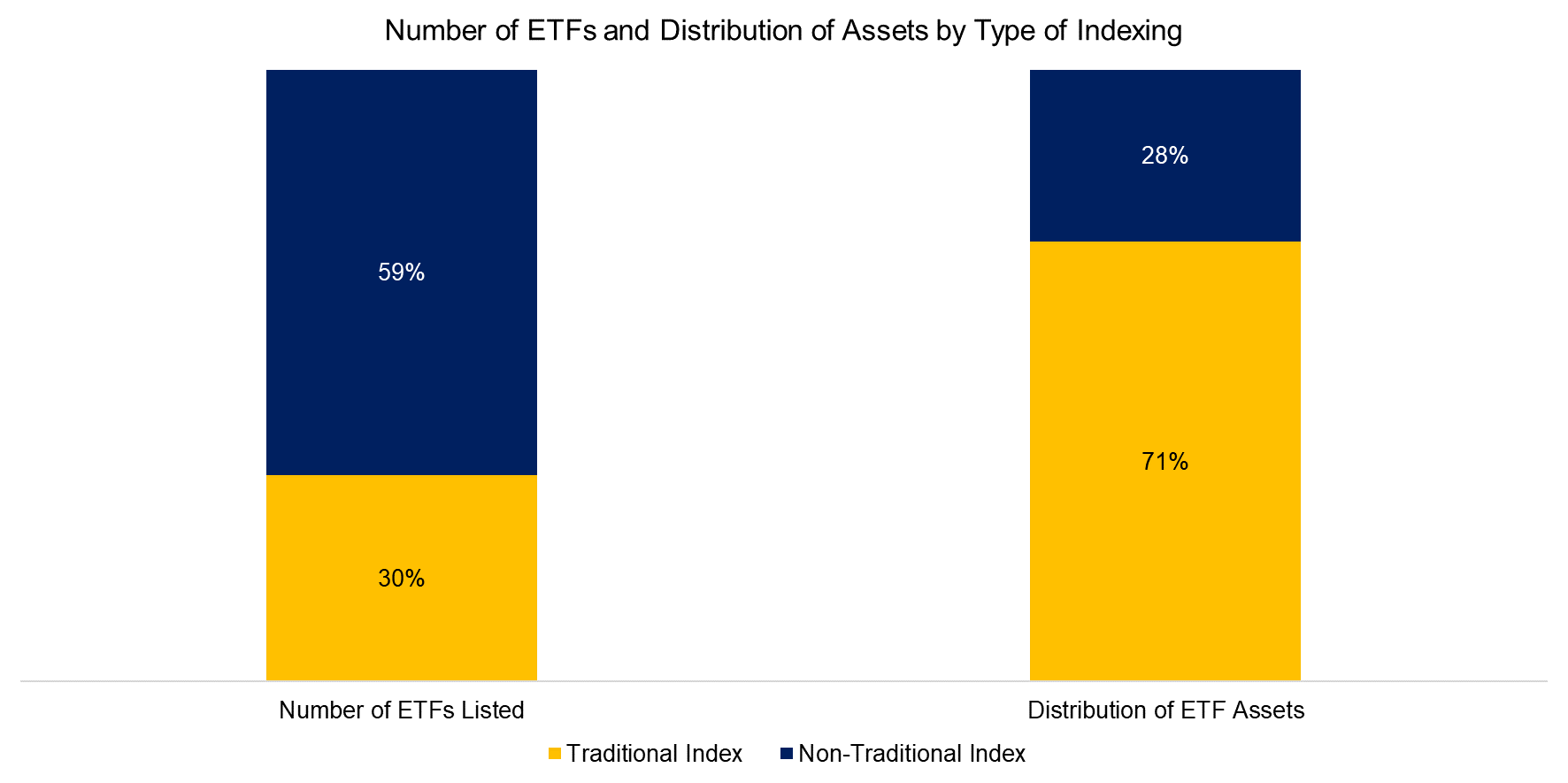
Source: ETF Think Tank
A HORSE RACE OF INDICES
Investors are always scouring the markets for opportunities to outperform and different stock-weighting methods may accomplish that. Our analysis of three indices with different weighting schemes found that equal and fundamental weighting generated higher returns than market-cap weighting since 1989. We determined fundamental weights through a combination of total assets, sales, and earnings.
Fundamental weighting was especially valuable when the tech bubble imploded after 2000, since fewer technology stocks and more old economy companies that ranked high in total assets, sales, and earnings were included in the index (read How Crowded are Tech Stocks?).
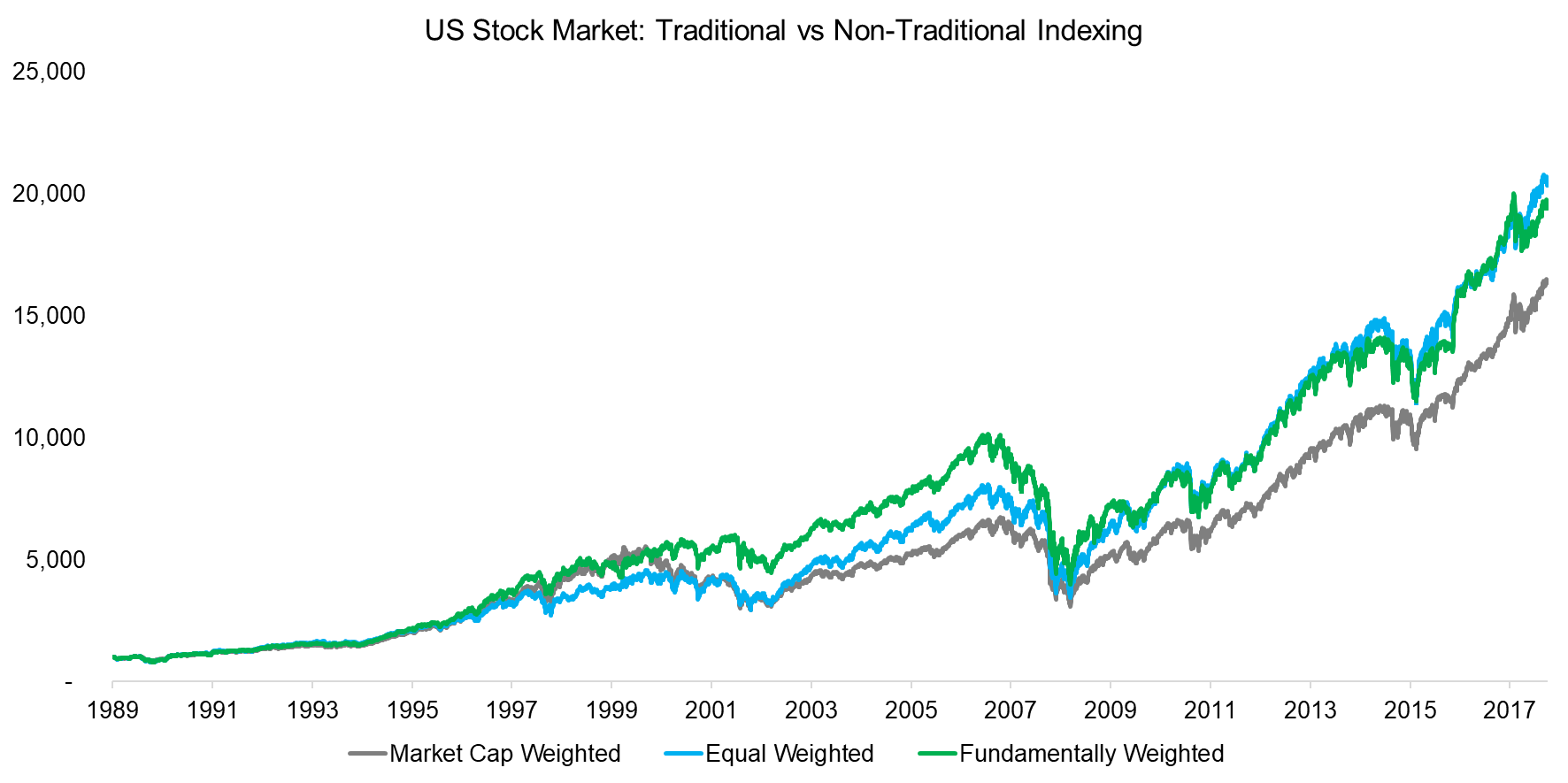
Source: FactorResearch
INDEX ANALYSIS
What explains the difference in performance? A sector breakdown covering the 1990 to 2018 periods yielded some insights and some distinctive portfolios.
- Market cap weighted: The financial and technology sectors dominate
- Equal weighted: Composed mainly of consumer discretionary and industrial stocks, which are numerous but smaller in market capitalization.
- Fundamentally weighted: Financials made up almost 30% of the index since they are the largest companies as measured by total assets, sales, and earnings.
Over the 30 years covered by this analysis, the sector compositions of the three indices changed only moderately.
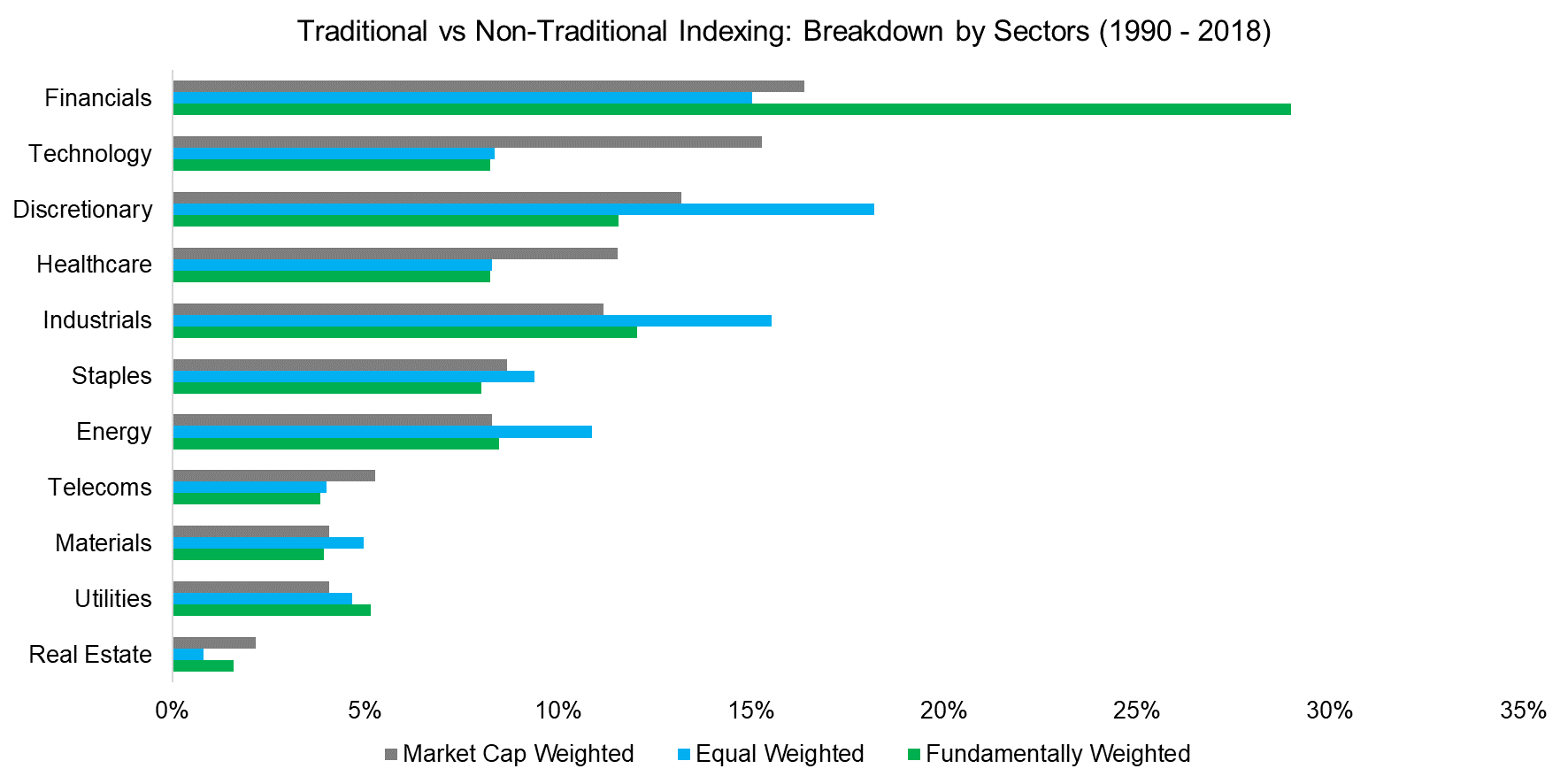
Source: FactorResearch
FACTOR EXPOSURE ANALYSIS
A common criticism of market-cap weighted indices is that they load up on Momentum stocks and suffer when sentiment swings against them. A factor exposure analysis reveals structural factor biases:
- Value: Fundamental weighting exhibits the highest exposure to Value, with significant exposure to financial stocks, which structurally rank cheap.
- Size: Equal weighting treats small and large stocks equally, so there is high Size factor exposure.
- Momentum: Despite the common criticism, market cap weighting does not lead to meaningful exposure to the Momentum factor.
The indices also differ with regards to the exposure to other common equity factors, but the factor betas are somewhat negligible.
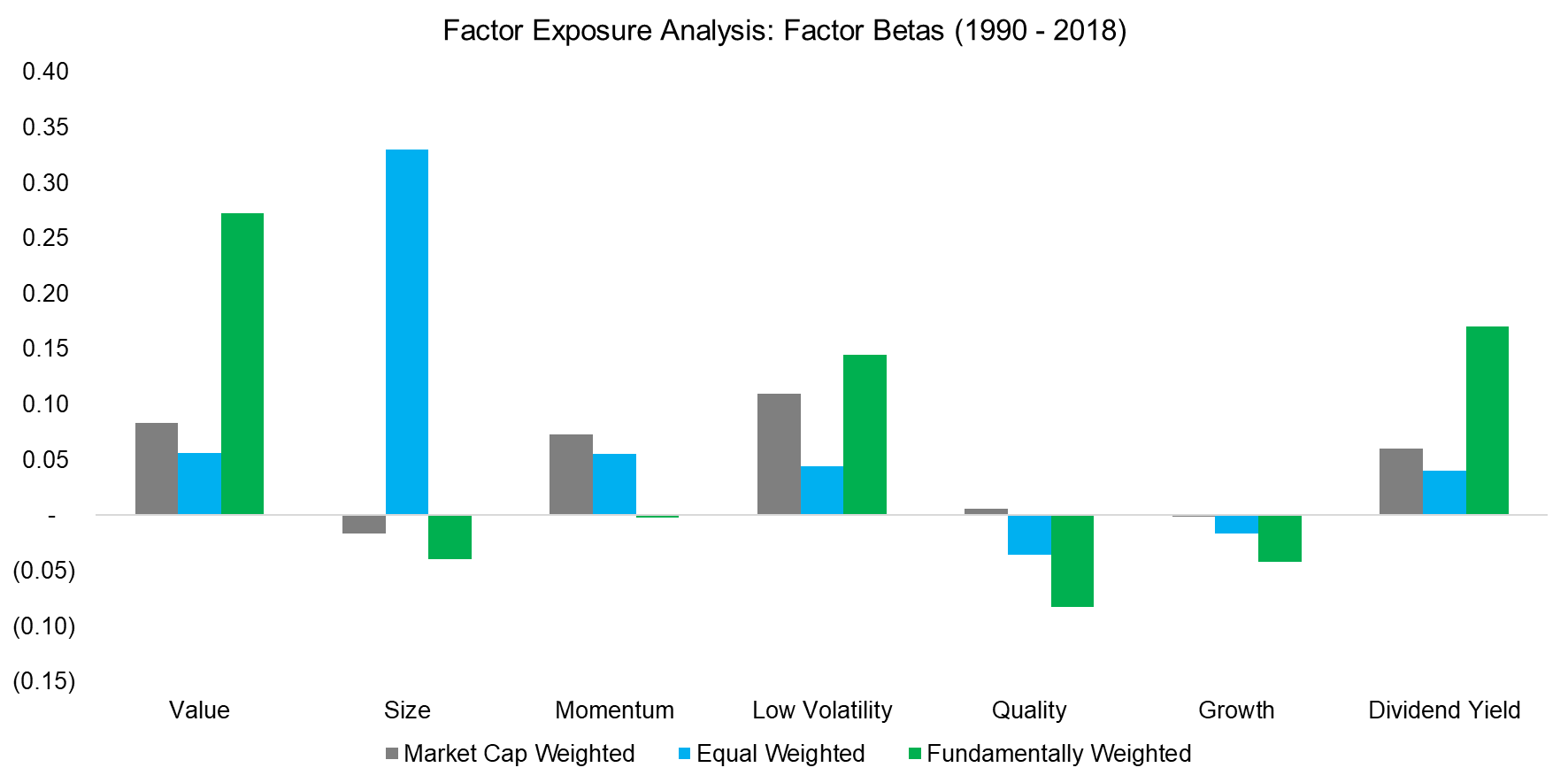
Source: FactorResearch
DISSECTING THE OUTPERFORMANCE
The exposure to certain factors might explain why equal and fundamental weighting outperformed market-cap weighting over the last three decades. An analysis of the annual returns per decade yields a more mixed picture in terms of under- and outperformance.
Market-cap weighted indices only yielded much lower returns between 2000 and 2010, which includes the tech bubble implosion when small and cheap stocks significantly outperformed large and expensive stocks. In contrast, the Value and Size factors performed less favorably between 2010 and 2018. In those years, market-cap weighting generated returns comparable to equal and fundamental weighting.
Given that non-traditional indexing provides exposure to certain factors, investors can simply replicate these characteristics with a combination of a market-cap weighted index and smart beta products.
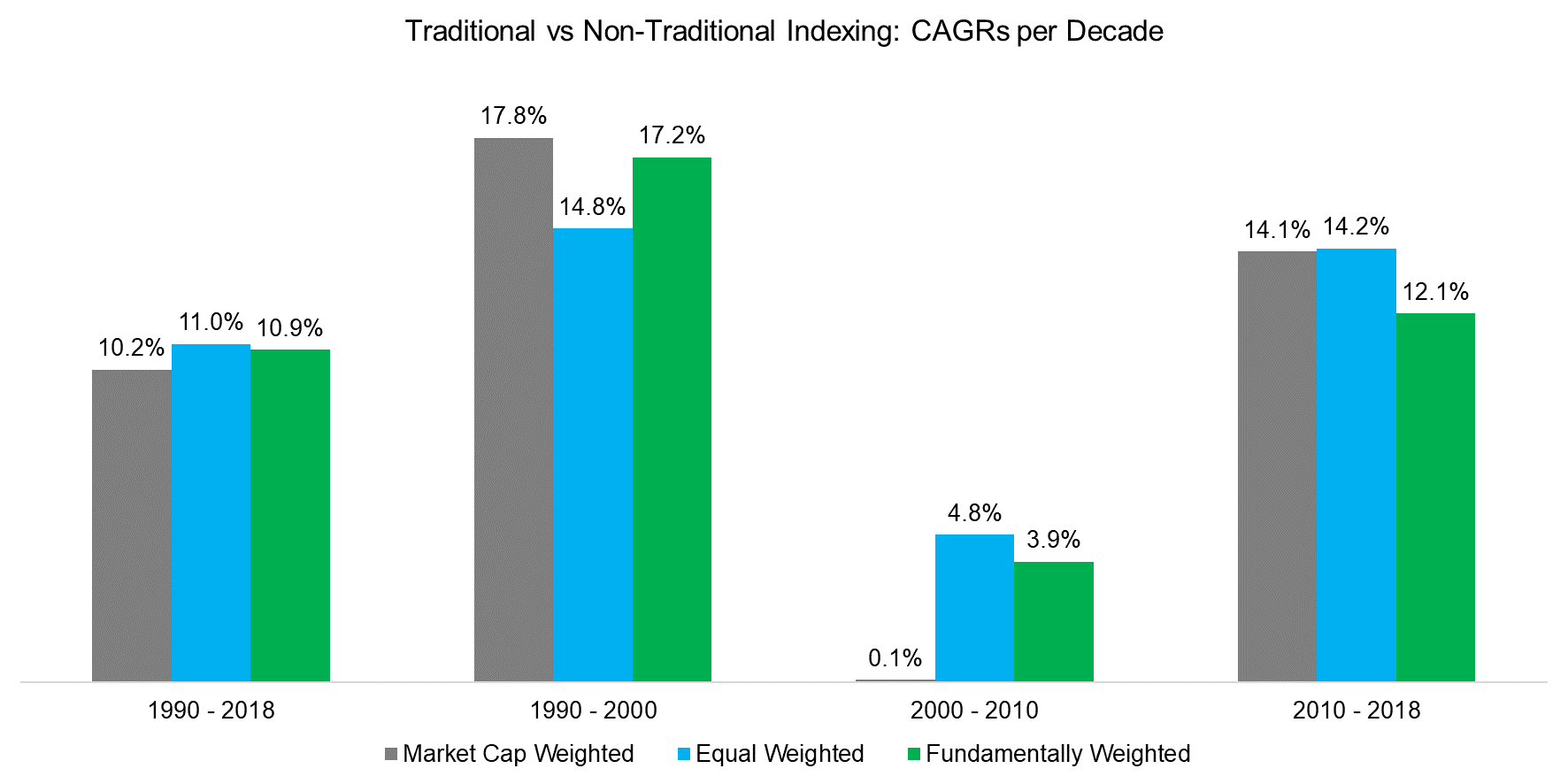
Source: FactorResearch
FURTHER THOUGHTS
Despite its presumed shortcomings, traditional indexing will probably retain its dominance because of its cost efficiency and adaptability: The portfolio constantly evolves and shifts with the market environment. Traditional indexing also benefits from its popularity and its anchoring in investors minds through well-known indices like the S&P 500. Furthermore, the only portfolio that all investors can only hold in aggregate is the market-cap weighted portfolio.
But there is a case for using non-traditional indexing in smart beta and other products. Stocks can be weighted equally or by their factor exposure with some reasonable constraints. This will result in better products from a factor investing perspective. For example, research across global equity markets shows that small and cheap stocks have higher returns than just cheap stocks. Investors should not forget that market-cap weighting is the equivalent of shorting the Size factor, a staple in factor investing portfolios.
REFERENCES
Index Industry Association (IIA) Survey 2018
ABOUT THE AUTHOR
Nicolas Rabener is the CEO & Founder of Finominal, which empowers professional investors with data, technology, and research insights to improve their investment outcomes. Previously he created Jackdaw Capital, an award-winning quantitative hedge fund. Before that Nicolas worked at GIC and Citigroup in London and New York. Nicolas holds a Master of Finance from HHL Leipzig Graduate School of Management, is a CAIA charter holder, and enjoys endurance sports (Ironman & 100km Ultramarathon).
Connect with me on LinkedIn or X.

